This group arose prior to the Bablot conflict. These northernmost Nodites were the descendants
of those who had forsaken the leadership of Nod and his successors for that of Van and Amadon.
Urantia Book 860
The
following is mainly written for UB readers concerning the Vanites. The
question is, who are the descendants of the Vanites that contributed to
the Assyrian stock? Are the Hurrians or the Subarians the Vanites
much later descendants? I think we can figure this out based on
several statements from the Book and what we historically know about
them. We
know that they, the Vanites who are comprised of the Amandonites and
those Nodites who chose to follow Van, lived in northwestern and
northern
Mesopotamia starting after the rebellion all the way down to
the times
of the Assyrians. The following is my understanding of the historical
material,
with its various viewpoints, which varies somewhat from what has been
published
by academia.
First is, where did the Vanites live? "Some
of the early associates of Van settled about the shores of the lake
which still bears his name, and their traditions grew up about this
locality." (UB 860) These Vanites were later joined by
the western or Syrian Nodites. "The
remnants of the nationalistic or racial memorialists journeyed
northward, uniting with the Andonites to form the later Nodite centers
to the northwest of Mesopotamia. This was the largest group of the
dispersing Nodites, and they contributed much to the later appearing
Assyrian stock." (UB 859) "Ten thousand years ago the Vanite ancestors
of the Assyrians taught that their moral law of seven commandments
had been given to Van by the Gods upon Mount Ararat." (UB
860) So,
it is clear that the ancestors of the Assyrians are predominately
Nodite
both from the Vanite and the western Syrian group. Now the question is,
can we identify these Nodite descendants?
As far as archaeology is concerned it begins with the grouping together, under an umbrella term, the people of Mesopotamia - the various prehistoric tribes, clans and associations as a starting point for the historic where different peoples can then be identified. The three terms I have read for these people are the "Pan-Subarian", "Japhetic" and "Proto-Hurrian." From this prehistoric group emerge four main groups that are interrelated. They would be the Hurrians, Sabarians, Mitanni and the Urartians. The location for the Mitanni and the Urartians is fairly well documented. The location for the Hurrians and the Sabarians is a considerable expanse of territory across northern Mesopotamia. Different historians put them anywhere from eastern Anatolia (adjacent to the Hittites) and (later) east to the Caspian Sea and beyond into Central Asia. These last two are the two main groups we will be looking at. The Hittites who lived more westward in Anatolia "stemmed directly from the Andonite tribes which had long inhabited these central regions." (UB 896)
The
greatest evidence for these people is linguistic and in particular
their proper names. Some archaeologists consider the
Sabarian and Hurrian as the same people. E.
A. Speiser considers them as the same with his
preference for the term Hurrian as their most fitting designation. His
work
on the origin of the Hurrians is now considered the standard. Ignace
Gelb, a contemporary, considers them as
different but his argument has been eclipsed by Speiser. But Gelb has a
lot of valuable information concerning this history (see below).
Although I agree that the
Sabarians are ethnically of the Hurrians, I think that because they
appear as a specific people in the Greek (Sabirs/Sapirs), Akkadian (Subartu), Assyrian (Supri/Sapar-da/Subartu/Subarri), Persian (Sabarda/Matiene/Mada), Old Babylonian (Subar),
Neo-Babylonian (Subartu), Egyptian
(Subari) and Sumerian Ur III
texts (Shubir/Subar/Subartu/Shubur)
that they are a distinct political
entity living in a land with definite boundaries. The Babylonians
separated the Subarians from the Assyrians because both are mentioned
as attacking Babylon. Even
the Assyrians warred with the Subarians but then the Assyrians warred
with
just about everyone. Sometimes they are understood as the Hurrites or
Horites. They most likely are the
forerunners to the Scythians
and the
Hungarians. The important point to remember is that Subarians equate
with Hurrians. They are the same people but politically different. It
is important to discuss the Sabarians because of
what
is said about them and what is said of them also applies to the
Hurrians who I believe are the later descendants of the Vanites.
Ignace J. Gelb:
"He
[Ungnad] found Subarian merchants and slaves living in Babylonia as
early as 2500-2000 B.C; he believed that Assur, the early capital of
the Assyrian Empire, was built by Uspia and Kikia, whose names
according to him are Subarian.
"Speiser's extensive interest in
the Nuzi tablets soon led him to a further discussion of the Hurrian
problem, this time, however, with entirely different results in
relation to the oldest population of Mesopotamia and neighboring
regions. As stated in his own words in his stimulating and attractively
written book, "the central thesis of this essay is, briefly, that
nearly all of the hitherto unclassified cultures and peoples of the
ancient Near East can be organized into a single, genetically
interrelated, group; the members of that group formed the basic
population of Hither Asia, produced its earliest civilizations, and
have continued to this day to furnish its ethnic background." For
convenience he calls the whole group "Japhetic," utilizing a term first
introduced by the Russian scholar Nicholas Marr, who applied it to the
Caucasus.
"His book is dedicated mainly to the Eastern
Japhethites, whom he further subdivided: "The peoples of the Zagros,
among whom the Elamites, the Gutians, and the Kassites, were most
prominent, have been found to constitute an eastern group, while the
Hurrians formed the western division of the peoples under
discussion." The chief representatives of the eastern group, "the
Elamites, ....were the original, pre-Sumerian, population of Babylonia.
The Hurrians furnished the substratum in Assyria with this essential
difference: they entered more prominently into the make-up of the later
Assyrians, than the Elamites appear to have done in the case of Sumer
and Akkad.
Such, in brief, is Speiser's
theory: Everything
unknown or little known in the ancient Near East may be summed up as
"Japhetic." Of the Japhethites in Mesopotamia and neighboring regions
the Hurrians and Elamites played the most important roles. The Elamites
in the south formed the basic population before the coming of the
Sumerians, while the north was settled by the Hurrians before the
Assyrians appeared." I
think this is very insightful. There were four main groups of Nodites.
For archaeologists to see a north and south division between them is impressive and it was mainly the northern group that served as the substratum
for the Assyrians. Another
term
for Japhetic which is more neutral is "proto-Hurrian" which is the term
I think is most appropriate for these people. "Ungnad
arrived at the far-reaching conclusion that the Subarians formed the
aboriginal population of the whole region extending from Palestine to
Armenia or even to the Caucasus and that even in Babylonia they perhaps
preceded the Sumerians. In much of the art usually considered to
represent Hittites he was inclined to see Subarians; and he even
suspected that the so-called "Hittite hieroglyphic" writing was really
the oldest writing of the Subarians. Thus began Ungnad's Pan-Subarian
theory, which was destined to exercise a permanent influence on the
writings of many authors to come."
(https://oi.uchicago.edu/sites/oi.uchicago.edu/files/uploads/shared/docs/saoc22.pdf)
Ungnad seems to
have developed a theory slightly before and similar to
Speiser for
groups of indigenous people with the catchall description of
Pan-Subarian just like Japhetic and proto-Hurrian.
(Ignace J. Gelb, Hurrians
and Subarians, The University of Chicago Press ©
1944
https://oi.uchicago.edu/sites/oi.uchicago.edu/files/uploads/shared/docs/saoc22.pdf)
It
is the country of Turkestan (above text), now Turkmenistan, that I find
most
surprising in this quote. It was in the most southwestern part of
Turkmenistan, the Kopet Dagh, where Van's
most eastern headquarters was located.
"A
casual reading of The URANTIA Book might give the impression that Van's
headquarters were primarily in the Lake Van area (35). A more detailed
analysis and comparison of statements in The URANTIA Book indicates,
however, that Van's principal headquarters were in the foothills south
of the Kopet Dagh, where Adamson subsequently settled (36). In this
connection, The URANTIA Book explains that the Vanites (early followers
of Van) and their descendants later settled about the shores of Lake
Van and their subsequent traditions developed around this area (37)."
(http://www.starspring.com/copiedfromfacebook/UrartuCopiedFromFacebook.html © Troy Bishop)
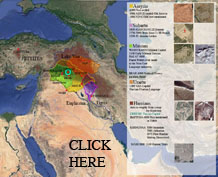 The
map of these northern kingdoms (the Mitanni, Urartian, Sabarian and
Assyrian) vary,
sometime a lot, according to the time frame as they expand and contract
even disappear over time. This map shows the various locations based on
an average size of their history. It is not based on dates. It is like
all ancient maps - an
approximation - and in this case I group all kingdoms on one map for
easy reference to help explain where these
kingdoms existed. As
for the location of Subartu the general area would be northeastern
Mesopotamia with the locations of Nuzi (Gasur) and part of Assyria
within it (3,000 BC). Academically, its true location remains unknown.
My
location for Subartu is based on the cuneiform texts and coupled with
natural barriers. It makes the
most sense looking at the geography of the
area. It is bounded by three
rivers and a mountainous range. Although there are other locations,
indicated very generally or sometimes just a name with no boundaries, I
prefer this as that bounded location.
You will find references that Subartu is Assyria.
This is based on certain Sumerian texts which point to a common origin.
Therefore Subartu must be at least adjacent to Assyria. The Assyrians are most
certainly related ethnically to the Subarians but Subartu itself was
its
own individual country. And as considering ethnicity, the Assyrians
were Hurrian to begin with (based on the early settlement
of Assur) and
only later became Semitic as was the the case for the
rest of Mesopotamia including Akkad, Babylonia and Sumeria.
The
map of these northern kingdoms (the Mitanni, Urartian, Sabarian and
Assyrian) vary,
sometime a lot, according to the time frame as they expand and contract
even disappear over time. This map shows the various locations based on
an average size of their history. It is not based on dates. It is like
all ancient maps - an
approximation - and in this case I group all kingdoms on one map for
easy reference to help explain where these
kingdoms existed. As
for the location of Subartu the general area would be northeastern
Mesopotamia with the locations of Nuzi (Gasur) and part of Assyria
within it (3,000 BC). Academically, its true location remains unknown.
My
location for Subartu is based on the cuneiform texts and coupled with
natural barriers. It makes the
most sense looking at the geography of the
area. It is bounded by three
rivers and a mountainous range. Although there are other locations,
indicated very generally or sometimes just a name with no boundaries, I
prefer this as that bounded location.
You will find references that Subartu is Assyria.
This is based on certain Sumerian texts which point to a common origin.
Therefore Subartu must be at least adjacent to Assyria. The Assyrians are most
certainly related ethnically to the Subarians but Subartu itself was
its
own individual country. And as considering ethnicity, the Assyrians
were Hurrian to begin with (based on the early settlement
of Assur) and
only later became Semitic as was the the case for the
rest of Mesopotamia including Akkad, Babylonia and Sumeria.
"Most
scholars suggest that Subartu is an early name for Assyria proper on
the Tigris and westward, although there are various other theories
placing it sometimes a little farther to the east and/or north. Its
precise location has not been identified."
(https://www.revolvy.com/main/index.php?s=Subartu&item_type=topic)
"Assyria
was also sometimes known as Subartu and Azuhinum prior to the rise of
the city state of Ashur after which it was
Aššūrāyu, and after its
fall, from 605 BC through to the late 7th century AD variously as
Athura and also referenced as Atouria according to Strabo, Syria
(Greek), Assyria (Latin) and Assuristan."
(https://aratta.wordpress.com/2015/06/28/hausos-goddess-of-the-dawn/)
The brown area on the map is based on present day Kurdistan. As I have mentioned elsewhere, the Kurds by my theory are Nodite descendants. It was by looking at this Kurdish territory that I could more plainly see various relationships and I feel confident that this is also the territory of the Hurrians. Much of what I had read seemed to fall into place and this latest research only strengths my conviction. The Hurrians were mainly a mountain dwelling people but did expand south. They did have their time of domination just like many different groups did. They became the power brokers of their time even bringing Assyria under their control. "The Hurrians, who seem to have operated on a grand scale, having their 'contacts spreading well into Europe', have been related by some scholars to the Finno-Ugrians, a conclusion that has been drawn from their language." (Gösta Werner Ahlström, The History of Ancient Palestine, Sheffield Academic Press, © 1993) When they were in their decline, around 1300 BC, they moved back into the "Hinter Land" also called "Hinter Asia" which would be the mountainous area on the map where the text Lake Van is located. Although some maps have Kurdistan as being as far south as to the eastern side of the Persian Gulf, this map stops at Elam. I go with this map in part because of it. The Western Syrian Nodites may have become, at least in part, culturally Vannic and therefore different from the Elamites who so long ago they moved away from, which is why I interpret this map of Kurdistan as correct and ending at the boundary with Elam. And this agrees with Assyriologist E. A. Speiser's division of the northern and southern groups of indigenous peoples.
"The Hurrians were so ubiquitous that many Indo-Iranian and Indo-European peoples are believed to have substantive Hurrian contributions in their ethnogenesis. For example, the Kurds consider themselves and their culture as descendants of the Hurrians and their civilization, despite linguistic differentiation." (Amjad M. Jaimoukha, The Chechens: A Handbook, RoutledgeCurzon © 2005 p 28)
"Subartu may have been in the general sphere of influence of the Hurrians. There are various alternate theories associating the ancient Subartu with one or more modern cultures found in the region, including the Armenians. The Kurdish scholar Mehrdad Izady, claims to have identified Subartu with the current Kurdish tribe of Zebari/Zubari/Zibaris inhabiting the northern ring north of Erbil, east of Mosul up to Hakkari in Turkey. (https://www.revolvy.com/main/index.php?s=Subartu&item_type=topic)
"Although
Hurrians were present in Northern Mesopotamia and the country between
the Tigris and the Zagros mountains from the first half of the third
millenium B.C., their home territory was in the region of Lake Van in
eastern Anatolia and the high land zone between the Upper
Euphrates and the Caucasus. Archaeological finds in this area manifest
a general uniformity of material culture from the last quarter to the
fourth millenium B.C., suggesting ethnic unity and pointing to
continuous occupation by the Hurrians from that time onwards."
(http://s155239215.onlinehome.us/turkic/20Roots/260Convergence/Hungarians/EndreyASonsOfNimrodCh7-9.pdf)
The
origin of the
Hurrians is across northern Mesopotamia from the shores of the
Mediterranean to northern Iran. This is where the Vanites and Western
Syrian Nodites
settled
down. But from the Sumerian record they seem to emanate from in or
about the location of Subartu and advanced westwards. This migration is
the supposed reason
that they show up in the west in Hittite territory in
Anatolia. However, the Hurrians appear in Hittite texts some one
thousand years before they are found in the Sumerian texts of Ur.
"Of the two
designations, “ Subarian ” was the first
to confront
cuneiformists
— in a variety of sources from Mesopotamia.
“Hurrian
” was encountered later, along the western fringes of the
region..."
(E. A. Speiser, Hurrians
and Subarians,
Journal of the American Oriental Society, © 1948)
The capital city of the
Hurrians was Urkesh in the Kingdom of
Mitanni. That is the archaeological
location and of all the cities
mentioned so far it is the only one that begins with UR.
"Events of
vast
significance have occurred in that small area of the world, ringing
down their consequences through the ages. Perhaps some day we shall
know more about this subject. One thing is becoming increasingly clear:
The modern revelation contained in The URANTIA Book is not merely a
theoretical article of belief to be sheltered from all links with
external reality. Even the word Urantia, which we URANTIA Book readers
know as the name of our planet, is not, it now seems, new to this world
(a possibility that brings a comforting sense of continuity with the
past): the similarity between Urantian and Urartian is too close--the
ubiquity of the Ur prefix too universal. Perhaps someday scholars will
find a new inscription or discover a new language fact and show that
the exact term Urantia has been in widespread use on our world for ages
upon ages.
"The word
Urantia, the
revealed universe name of our planet, was known to Van. Derivatives of
this word have abounded in the area where Van dwelt, working their way
into the languages and traditions of men since time immemorial. Some
are obvious, while others are speculative: Urartu--Ur--King Ursa--Ural
Mountains. Perhaps it is wrong to look to ancient definitions of the
word Ur and its derivatives to find clues to the significance of the
name Urantia. Perhaps, as a revealed name, this word has given all
human languages their variously and imperfectly perceived
interpretations of the true universe meaning of the prefix Ur."
(http://www.starspring.com/copiedfromfacebook/UrartuCopiedFromFacebook.html
© Troy Bishop)
"It is only after this Hurrian expansion that the name ‘Hurri’, or more exactly fc/ш гп', makes its first appearance in contemporary sources and this has led Ungnad to suggest that that name does not designate a people but only a political concept, such as ‘federation’ or ‘union’. However, Hrozny has established that there was also a city called Khurri or Khurra mentioned by that name in Assyrian and Babylonian records which was probably identical with modern Urfa (Edessa) and was the centre of the Hurrian empire. This makes it appear more likely that khurri was the name of the Hurrian people in their own language and that they applied the same designation to their capital.
"Assuming, therefore, that the carved jar of Karmir Blur was of Hungarian origin, its emergence among the ruins of an Urartian fort furnishes further proof of close Hurrian-Hungarian relations. These can be also traced in another important way. We have already referred to the fact that in early Christian tradition and Moslem mythology Edessa (Urfa) was particularly closely associated with Nimrod (Chapter 1 ), and we have also pointed out that this city was probably the capital of the Hurrians. It is therefore very likely that Nimrod was a Hurrian mythical figure, or perhaps even an early Hurrian ruler, and that he personifies that people in the Bible and Near Eastern tradition. Biblical references to the role played by him in Assyria are certainly consistent with the Hurrian occupation of that country and although there is no evidence that the Hurrians engaged in any large scale building activities throughout the Near East, it is quite possible that the Israelites simply attributed to them the works of the Sumerians of whom they had no memory. After all, the Hurrians were still around at the time the Genesis was written (c. 950 B.C.) but the Sumerians had completely disappeared nearly a thousand years previously." (http://s155239215.onlinehome.us/turkic/20Roots/260Convergence/Hungarians/EndreyASonsOfNimrodCh7-9.pdf)
With the decline of the Hurrians as a historical people, and after a victorious past, the Urartians that lived about Lake Van who were of Hurrian descent were able to become the dominant power of northern Mesopotamia during the Iron Age. So we have at least two major groups, the Mitanni and the Urartians who were Hurrian but were politically different and it is true for the Subarians.
Double Origins
"The Curator of the East
Asian Museum in Berlin, E. Mayer, states that the Hurrites were not
Semites and their name in Sumerian was SUBAR or SUBIR. In about 3500
B.C., the Sumerian people settled among the Sabir/Subir/Subarean people
who lived in this territory. This is probably the explanation of the
expression KAS-GAR which was found on the Sumerian tablets. KAS-GAR
means "double origins" (Sabir/Hurrite and Sumerian)."
(http://www.magtudin.org/Homeland%2010.htm) The "double origins" most
likely means divine and human.
"Some
Sumerian myths claimed that the god of Air en-Lil created man. Other
myths claimed that enKi created
man, but in fact the FinnUgor myths claim that the equivalent of Enki
known as "world caretaker" man, was originally
the ancestor of mankind. In a sense he is the father of mankind, but
not its creator.
This however may be but a variation in Sumerian of
the
Finn-Ugor idea of the dual origin of man, where one branch of humanity
is known known as MOS, coming from heaven and another branch known as
POR being the sons of earth has
Sumerian links that are a little bit changed, where "Meš" =
princely, man also while most people are derived from clay. The
term POR in Sumerian has the equivalent word PAR-im, which is dry-arid
land. Thus one group is believed to be the son
of the air god, while the other group is believed to be the son of the
earth. Perhaps this also gave the idea to the
Sumerians that certain of their kings were partly divine in origin, by
having a god or goddess as one of their parents, while the
other parent was human. This idea is echoed in the Bible as the Elohim,
the sons of god who intermarried with
the daughters of (earth) men. The story is greatly changed, but the
underlying facts are still the same."
(http://users.cwnet.com/millenia/Sumer-origins.htm)
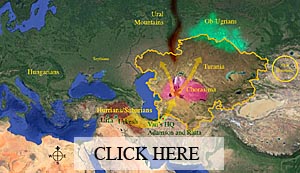 Very
interesting, the "double origins" concept found beyond Mesopotamia and
Enki as
"World Caretaker", what a nice surprise. It is also
a trail of connect
the dots. It appears that the Hurrians, but named as the
Subirs/Sabarians/Sapirs, migrated
eastward through what by now is a well known corridor that borders the
southern Caspian Sea. As they traveled
east into Turkmenistan they curved northward. That brings them into the
area that would later be called Chorasmia
with its welcomed oasis and considered by some historians as originally
settled by the Subirs. Their northward movement would be split by the
Ural Mountains funneling some to the east into Siberia but most to the
west into Old Europe the gateway to western Europe. Here it becomes
interesting. The land to the northeast, Siberia, would become the
origin of the Hungarians who would later migrate eventually to the
Carpathian Basin and claim it as Hungary. Siberia is also home to the
Ob-Ugrian and as some historians postulate, home to the FinnUgor
(with the suffix Ugor located both east and west of the Urals and most
likely with the same ancestry as the Ob-Ugrian if not the same
people. The difference in names might be related to a time frame and/or
the ethnology of the historian.)
Along with these early Hungarians came a language with strong Sumerian
ties, Siberian folklore and legends which is why some scholars have the
origin of the Hungarians in Sumeria itself. As for the Hungarian
language: "His
conclusion [László Götz] is that most
Eurasian
ethno-linguistic groups are related to one another in varying degrees,
and that these groups, such as the Indo-European, Uralic and Altaic
groups, were formed in a complex process of multiple ethno-linguistic
hybridization in which Sumerian-related peoples (Subareans, Hurrians,
Kassites, Elamites, Chaldeans, Medes, Parthians) played a fundamental
role." and that
"The
linguistic similarities between Sumerian, Hungarian and other languages
are corroborated by the archeological and anthropological data
discovered so far."
Very
interesting, the "double origins" concept found beyond Mesopotamia and
Enki as
"World Caretaker", what a nice surprise. It is also
a trail of connect
the dots. It appears that the Hurrians, but named as the
Subirs/Sabarians/Sapirs, migrated
eastward through what by now is a well known corridor that borders the
southern Caspian Sea. As they traveled
east into Turkmenistan they curved northward. That brings them into the
area that would later be called Chorasmia
with its welcomed oasis and considered by some historians as originally
settled by the Subirs. Their northward movement would be split by the
Ural Mountains funneling some to the east into Siberia but most to the
west into Old Europe the gateway to western Europe. Here it becomes
interesting. The land to the northeast, Siberia, would become the
origin of the Hungarians who would later migrate eventually to the
Carpathian Basin and claim it as Hungary. Siberia is also home to the
Ob-Ugrian and as some historians postulate, home to the FinnUgor
(with the suffix Ugor located both east and west of the Urals and most
likely with the same ancestry as the Ob-Ugrian if not the same
people. The difference in names might be related to a time frame and/or
the ethnology of the historian.)
Along with these early Hungarians came a language with strong Sumerian
ties, Siberian folklore and legends which is why some scholars have the
origin of the Hungarians in Sumeria itself. As for the Hungarian
language: "His
conclusion [László Götz] is that most
Eurasian
ethno-linguistic groups are related to one another in varying degrees,
and that these groups, such as the Indo-European, Uralic and Altaic
groups, were formed in a complex process of multiple ethno-linguistic
hybridization in which Sumerian-related peoples (Subareans, Hurrians,
Kassites, Elamites, Chaldeans, Medes, Parthians) played a fundamental
role." and that
"The
linguistic similarities between Sumerian, Hungarian and other languages
are corroborated by the archeological and anthropological data
discovered so far."
(http://www.hunmagyar.org/tor/controve.htm)
Here is more on the Hungarian-Sumerian connection: "There is therefore strong linguistic evidence that the ancestors of Hungarians lived in the Mesopotamian region during the third millenium B.C. and possibly even earlier. This evidence is supported by definite traces of Sumerian mythology and religious concepts in Hungarian folklore. The cult of the Great Stag, one of the personifications of the Sumerian god Enki, is reflected in numerous Hungarian Christmas and New Year’s Eve regos chants.20 It is perhaps not without significance that the melodies of these chants differ markedly from the pentatonic folk-songs prevalent in old Hungarian music and are generally regarded as of much more ancient origin.-1 Although the cult of a benevolent stag divinity is common to many peoples, Hungarians have also preserved his name, Dara-mah (Hungarian Doromo, Durumo), and the memory of his son Dumuzig (later Tammuz) survived in the Hungarian pagan god Damachek." (http://s155239215.onlinehome.us/turkic/20Roots/260Convergence/Hungarians/EndreyASonsOfNimrodCh7-9.pdf)
The map above includes an area labeled as Turania which is another name for Central Asia. If you do any more reading on this subject you will encounter it so I include it here.
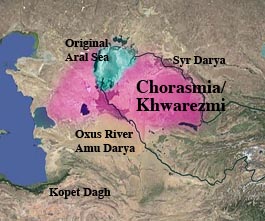 Chorasmia/Khwarezmi
Chorasmia/Khwarezmi
"The land of the Sumerians
The main
name for the land of Sumeria is also a rather enigmatic term
"Ki-Engi-ra" or sometimes "Kiengi". It is also not very well
understood. While KI=land, place as in FinnUgor *kila, the following
Engira or Engur, however doesn't seem to make much sense in this
context, since it means fresh-underground waters. Interestingly there
was in ancient times another great city-state, which lasted until the
coming of the Mongols, next to the Aral Sea. It also was a land of
extensive canals and irrigation and known by a very similar name
locally as Kanga. The Persians and most historians knew it as the
kingdom of Choresmia. According to Russian archaeologists and
historians
it was probably founded by the Hurrian-Subarians. Its also
interesting to know that the Subarians were also known even by the
northern Ob-Ugrians, as Sapir and were admired for their superhuman
knowledge and abilities, probably as the carriers of a very ancient and
high civilization."
(http://users.cwnet.com/millenia/Sumer-origins.htm)
My above map is a composite of several maps. It
has Chorasmia between the Amu Darya and the Syr Darya rivers with the
inclusion of the agricultural region directly south of the Aral Sea and
all the way west for access to the Caspian Sea. The Amu Darya flows
into the Aral Sea from Afghanistan and today the sea is just
about gone.
"From about 30,000 to 10,000 B.C. epoch making racial mixtures were
taking place throughout southwestern Asia. The highland inhabitants of
Turkestan were a virile and vigorous people. To the northwest of India
much of the culture of the days of Van
persisted." (UB 870)
The beginning of agriculture in
this region dates back to about 3000 BC. At
about 1000 BC a Neolithic culture flourished in the Chorasmian oasis
but the first historical reference is from the Avesta at about 500 BC. The
archaeological
record shows that the technologies of civilization traveled north from
the BMAC. An
article on
http://www.iranicaonline.org/articles/chorasmia-i,
dates the
kingdom of Chorasmia to 600 BC
for the approximate start of its establishment.
The
kingdom of Chorasmia which would include the older Oxus civilization
also known as the BMAC the forth civilization to arise with Sumeria,
Harappa and Egypt
was located partly in Uzbekistan, Turkmenistan and Kazakhstan and
borders the Aral Sea. These
are the three largest of the countries of Central Asia. Also included
would be Kyrgystan and Tajikstan. Afghanistan is sometimes also
included. "There
are indications that some kind of kingdom had come into being as early
as the thirteenth century BCE. The first of these is the fact
that ancient chronographers knew a Chorasmian era, which dated back to
1292 BCE.
The second
indication is that according to the Gâthâ's,
Avestan texts
written in the fourteenth or thirteenth century, the prophet
Zarathustra was protected by king Hystaspes of Chorasmia."
(http://www.livius.org/articles/people/chorasmia/)
"The
Hurrian descendants also founded the kingdom of Urartu as well as the
central Asian kingdom of Khwarezmia, next to the Aral Sea.(
S.P.Tolstov, Ancient Khwarezmia, Moscow, 1947 ) [Some Russian
researchers claim that Khwarezmia and its area was the possible origin
of the Finno-Ugrian and Altaic nations!] The people of Subartu
(Hurrians and Subars) lived predominantly in northern Mesopotamia but
in very ancient times also in southern Mesopotamia."
(http://genesisjournal.blogspot.com/2004/09/hungarian-ethnic-designations.html
The Russian
researchers point to Chorasmia/Khwarezmi
as a possible homeland of the Finn-Ugrians to the north and the Altaic
peoples more to the east. They are probably right. We do not know of
any estimates of population size of this collective of "Subirs" but it
was enough (along with the earlier Andites and Adamites) to influence
this entire region. We also have no real date
of when the Subir-Hurrians migrated to Central Asia. The beginning of
the Neolithic seems possible as there is evidence of very early
irrigation. That would mean they were on the heels of the Andites and
reinforced those epic memories of the past.
"The
previous summary illustrates the fact that the Magyar and Sabir names
have been found in Northern Mesopotamia since the dawn of history, but
they may mislead one to think this is the only place where it was
found. Actually one can trace it to the east of this area to the
Turanian Lowlands and Turkestan also, where even today there are a few
place and geographic names which recall their presence. The Persians
split the Sabir people and only one branch lived in the Caucasus while
another further east. This is how the Sabirs gave their name to the
northern Asia in the name Siberia."
(http://genesisjournal.blogspot.com/2004/09/hungarian-ethnic-designations.html)
Conclusion
Everything points to those Proto-Hurrians, as being the
substrata for the Assyrians, Sabarians, Urartians and the Mitanni. They
also
became a political entity unto themselves and they had a definite
cultural impact on the region as a whole. I have not delved into their
religious influence here but it was substantial. Of all the
religious
iconography
in this region the Tree of Life is dominant. This is confirmed in
Assyrian, Urartian and Mitanni art. Legends at this time would have
been known of the relationship of the Tree of Life to Van (the world tree),
to Eden
(in the concept of Divine Kingship) and perhaps, since they were
Nodite, from Dalamatia itself. So at this time frame of about 6000-1300
BC
we are post-Adamic, post-Andite and by 1300 post-Melchizedek.
Looking at the map with its Hurrian migrations I can see that Van's headquarters was no random placement. It is located where the Silk Road would develop in the future with its major thoroughfare of the migratory routes including the Adamic, the Andite, the Nodite, the Hurrian and others. It is a strategic location for what Van needed. It was an excellent jumping off point for his missionaries to seed the known world. It was a doorway for his legend to travel between east and west. Shortly after Van departed, Adamson, Adam and Eve's first born, who married Ratta settled here to raise their family. It would continue this Mesopotamian history of the rebellion, its epic consequences and the story of the miraculous Tree of Life.
It would be in this area of Turkmenistan where the Tree of Life grew and where Van and Amadon lived all those millennia. And that presents a bit of a problem. Specifically the World Tree and Shamanism. The Tree of Life is as involved in Mesopotamian religion as it is in Shamanism. There are many common features of the Tree in Mesopotamia and in Central Asia. I do not think we will be able to untangle this knot of where or when differing concepts, regarding the Tree, originate.
I still have questions about the relationship, if any, between the Hurrians and the Andites. I am assuming that there was, as they both lived in the same basic area of northern Mesopotamia for thousands of years. History and geography indicates that the Hurrian were more of a people of the mountains and the Adamites more plainsmen with their focus on agriculture. The Adamites migrated west across the Mediterranean Basin until it flooded, south into Egypt and east into Turania but they do not seem to have migrated that much north and that may be the reason that the Andites and the Hurrians seem to be two distinctive groups. By 6000 BC the Andites were essentially gone except for the southern Sumerians. That would leave the indigenous people of the north, the Vanites, those Amadonites with a component of Nodite blood but not enough Adamic blood to qualify as an Andite and the two groups of Nodites who by this time were most likely amalgamated into one roughly homogeneous group (the northern Nodites) as the emerging proto-Hurrians. So the genetic weight of the Hurrians is Andonite and Nodite. There also would be those Sangiks that would round out this group. That's guesswork but it would satisfy: a people who continued to keep alive the legend of the Tree of Life, the rebellion, the epic event of the mixture of human and divine blood, the traditional belief in the reality of Van as Enki and as a group of aboriginal people cohesive enough to become contributors to the substrata of Mesopotamia.
One of the Sumerian appellations for Enki is "caretaker of man". "Sumerian KIG > KI, better known as EnKI and EA=god of waters, wisdom, magic, caretaker of man. He seems to be a combination of several earlier gods, because of his wide range of functions and many titles. One of the Sumerian caretaker of man Hungarian KEGY = mercy (Sumerian Kiag = love, care) The FU [Finn-Ugor] myths about the "world care taker or world ranger" fits with enKI in that he teaches and looks out for the benefit of mankind. Enki's other name is DARAMAH which can mean great stag, but may be related to the FU chief god TAREM in Ugrian or the god of weather /atmospheric TIER-MES in Lappish. Hungarian teremt�=creator. As the magician-shaman of the gods several FU names related to prophecies and magic also relate to Sumerian, along with the meaning of water and river, which is also his chief element. IA in Finn-Ugor is *YO-(ki) , or YO in some languages means river, but yos is also a prophet. The Y was replaced by a leading I in Sumerian. There is evidence that the Finnish water god HIISI, who took on the form of a stag but was later demonized, was once also similar to EA." (http://lunaticoutpost.com/showthread.php?tid=363903)
From the Sumerian epic "Enki and the World Order" is this quote:
166-181
The lord, the great ruler of the Absu issues instructions on board the 'Stag of the Abzu'
-- the great emblem erected in the Abzu, providing protection,
its shade extending over the whole land and refreshing the people,
the principal foundation (?), the pole planted in the ...
... marsh, rising high over all the foreign lands."
100-122
"The lords ...... to me. I am Enki! They stand before me, praising me.
The abgal priests and abrig officials who ...... stand before me ...... distant days.
The enkum and ninkum officiants organise ....... They purify the river for me,
they ...... the interior of the shrine for me.
In my Abzu, sacred songs and incantations resound for me.
My barge 'Crown', the 'Stag of the Abzu', transports me there most delightfully.
It glides swiftly for me through the great marshes to wherever I have decided,
it is obedient to me. The stroke-callers make the oars pull in perfect unison. They sing
for me pleasant songs, creating a cheerful mood on the river. Nijir-sig, the captain of my barge, holds the golden sceptre for me. I am Enki!
He is in command of my boat 'Stag of the Abzu'. I am the lord! I will travel! I am Enki!
I will go forth into my Land! I, the lord who determines the fates, ......,"
Enki and the World Order: Translation - http://etcsl.orinst.ox.ac.uk/section1/tr113.htm
"Myths of Enki, The Crafty God" by Samuel Noah Kramer
"Enki's boat is spoken of in the myth "Enki and Ninhursag", where this god's boat is called the 'Stag of the Abzu', which according to R. Biggs may relate to some pre-anthropomorphic conception of Enki as a stag, and Enki is still sometimes himself referred to as 'stag of the abzu' (http://enenuru.net/html/BalageArtDesc/EnkisBoatTrip.htm)
The name for Enki's boat also called a barge is named "Crown" which I assume is a reference to the winged disk at the very top of the Tree of Life. That is not to say that it is not an actual boat, as Black and Green suppose, as there have been such boats discovered in Egypt. (One such boat, the Khufu ship, was found at the foot of the Great Pyramid of Giza and measures 143 feet or 44 meters). In my opinion the actual boat represents the celestial one and that is how the gods travelled. It could also refer to the horns of the stag. If the Hungarian myth of the white stag, Hunor and Magor (aka Gog and Magog) is older than this Sumerian story of Enki then R. D. Biggs may be correct. It could be that the white stag may be a totemistic ancestor of those earlier proto-Hungarian tribes. Inanna, a Sumerian goddess, also has a boat called the "Boat of Heaven" which seems to reference the winged disk. And Ra the Egyptian sun god also had his boat sometimes called the "Barque of Ages" or "solar barge" which was directly connected with heaven (sometimes carrying the souls of the dead). So, there are two subjects here, the stag and the boat. Enki's "Stag of the Abzu" refers to his barge which may be a metaphor for the winged disk and maybe not. I have not found any reference of Enki as the stag to the white deer of folklore. I have seen examples of the relationship of Enki and variations of his name connected to the great stag but not specifically to the Hungarian white stag. Within this epic of "Enki and the World Order" is another description which I think makes much more sense as you will see further on down this page in the section labeled The Goat:
My magur-boat, the crown, the ‘ibex of the Abzu’ –
In its midst there is a great rejoicing.
The lofty marshland, my favorite spot,"
What names refer to is one of the problems in understanding what is written in these epics. For instance, Enki has at least two other epithets. The most used is Nudimmud and the other is Ninigiku which is used by the Assyrians and Babylonians (and most likely the Akkadians who were Semitic and changed Enki to Ea). Linguists are not sure as to why this usage. Many times these names are used in conjunction with Ea as in Ninigiku-Ea from the Epic of Gilgamesh and Nudimmud-Ea from the Enuma Elish. Other times they are used alone. In my opinion this situation is not unlike the names used for the Tree of Life. Two names, Huluppu and mes, are for the same thing but refer to different aspects. We know of another Enki name mystery because he is named as Lord of the Earth but is understood as the Lord of Water as in the Abzu. I understand this dualism as being related to the alternate names above for Enki/Ea. Both are used with the subject of creation be it the world or humans. As far as the Earth/Water question, I think he is both but it depends upon context. He certainly is associated with water, overwhelming so. His home is in the watery deep of the Abzu and may be connected with the marshy environment of Eridu. And that brings us back to his other title the Lord of the Earth. And this is where the "world caretaker" fits in. Enki as found in different cultures is a world caretaker and the caretaker of man. In other words he is the "Lord of the Earth". There is yet another possibility which is explained further down this page and that is Enki's abode is measure by the 1-iku. This measurement applies to the size of his watery temple and to a unit called "the field" which is a direct connection of Enki to the land.
The Ob-Ugrian Religion: "World-Overseeing Man (Man., Mir Susne Xum; Kh., Mĭr Šawijti Xu; wild goose, crane; moś moiety; village of Belogorje). His other names include Golden Lord, Horseman, and Upriver Man. He is the youngest son of the sky god, the central figure of Ob-Ugric religion, and functions as a mythic hero in the creation of the world order. Married to the daughters of persons symbolizing nature, he excels in providing humans with their needs. His sphere of activity ranges through all three worlds. His is the highest position of honor among his brothers: the overseeing of the world and of humans. He accomplishes this by circling the world on his winged horse. In early formulations he is a solar god; later formulations preserve traces of the Shamanistic mediator: He is the chief communicator with Sky God."
(http://www.encyclopedia.com/environment/encyclopedias-almanacs-transcripts-and-maps/khanty-and-mansi-religion)
There is a somewhat similar belief among the Yurgans: "Comparisons of different Yugran traditions indicate that the goose was one of the shapes or appearances of the most popular god of the "World Surveyor Man", and that Belogorye is still sometimes referred to as his home. Novitsky also describes a site for worshiping this "World Surveyor" or "Ob Master":
"The home of the Ob Master among the Yugraner was presumably near the stronghold Samarovo in the mouth of the river Irtysh. According to their heathen belief he was the god of the fish, depicted in a most impudent manner: a board of wood, nose like a tin tube, eyes of glass, little horns on top of the head, covered with rags, attired in a (gilt breasted) purple robe. Arms - bows, arrows, spears, armour, etc - were laid beside him. According to their heathen belief they say about the collected arms that he often has to fight in the water and conquer other vassals. The frenzy ones thought that the atrocious monster is especially horrifying in the darkness and in the large waters, that he comes through all the depths where he watches over all fish and aquatic animals and gives everyone as much as he pleases." (Novitsky: 59)." (https://en.wikipedia.org/wiki/Yugra)
Named as the Yugrans they may be directly related to the Ob-Ugrians since they are located on the Ob River in Siberia where the Ob-Ugrians live. Important attributes of the World Surveyor Man are that he is bird-headed (and very popular). Second, his home is in water. And third, is his close association with fish, all of which are attributes of Enki. Then there is the all important description of his being the "World Surveyor" and as far as fish go, the "Ob (River) Master".
Further Siberian stories of the "World Watching-Man" has him associated with the swan:
"The Milky Way goes through this constellation - and behind it appears to divide into two (we now know this is due to dust clouds obscuring the stars near the centre of our galaxy). This has led to stories about the ski-tracks of the Swan Prince - also called World Watching or World Surveyor Man, as he watches over us. Not just swans but other water birds are associated with light and life and the sun - cranes, geese and ducks - and this iconography is still to be found across Europe and Asia.
" 'World-Surveyor-Man' also leads the Birds away each autumn - in the legends of Siberia and Northern Europe, to the World of the Birds. (The sun and the birds leave Earth for the winter). He led the birds along the milky way to the edge of the world where the sky meets the ground. Here they clash together and the birds must fly through while they they are open. In spring, the Swan Prince leads the birds back to Earth. Many do not make it safely through the crushing edges of the world, and the ground below is red with the crushed corpses of those who got caught.
"The Mansi/Vogul retained their original beliefs. To them the Sun God, was the youngest of the seven children of the Sky God Num-Tarem and the Great Mother Goddess Juli-Tarem. He was called Mir-Susne-Khum - which translates as World Watching Man or World Surveyor Man.
"His myths are similar to the Bear myths. He was sent by his father the Sky God to bring cultural benefits to man.
"The Aurora Borealis is caused by his shiny clothes and glittering white horse as he flashes through the sky."
(http://www.cosmicelk.net/mammothhunters.htm)
Once again we see attributes of Enki: waterfowl-like in the image of the swan, child of the sky god, a bestower of culture and riding a flying white horse which is part of another folklore belief of the Ob-Ugrians.
Included with all the Shamanistic trapping surrounding Enki is the concept of watching as in the World Watching Man. It may be just a strange coincidence but Enki, as one of the Anunnaki, is what the Bible's term for the Anunnaki says he would be - a Watcher. That means that the term "watcher" could come from the stories of those ancient shaman who lived in Siberia.
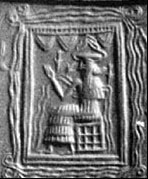
 We
do not hear much about this flying horse of Enki in the usual
information about him. But there is a connection with water and the
sky. We start with his abode in the Aspu. When depicted on seals and
the like he sits within a square on a cube-like throne. Sometimes his
symbol is a square with a cross inside. This square shape is also in a
constellation called AS-IKU. The Sumerians called this great square
"the field" (1-iku the 'One-Acre Field'). "The
god Enki is the most important of the deities in the flood myth, for he
is the one who specifically warns Utnapishtim of the coming of the
flood, and it is precisely this god who later became the sign of
Capricorn, for both the goat and the fish were sacred to him. As
Utnapishtim recounts the story of the flood to Gilgamesh, he tells him
that Enki warned him that Enlil planned to destroy humanity and that
Utnapishtim should build an ark shaped exactly like a cube ("her length
and breadth shall be the same"). This is a strange detail until we
realize that for the Mesopotamians the constellation of Pisces included
the so-called Pegasus Square between the two fish, and that this square
was known as "1 Iku," precisely the dimensions of the ark (an iku was a
unit of measurement equivalent to 3600 square meters)."
(http://www.mythicjourneys.org/newsletter_may07_gilgamesh3.html) The
name Pegasus is from the Greek which refers to the winged horse of
Poseidon the god of the sea but whose name translates as "Lord of the
Earth". One Greek myth has the winged white horse sired by Poseidon.
Enki is well known in that Poseidon is his later manifestation.
Therefore, the constellation named Pegasus in Greek is founded on
Enki's winged horse from those oral Shamanistic traditions about
the World Watching-Man. What the relationship is of Enki's
square water temple to the square of Pegasus is revealed from Enki and the World Order:
We
do not hear much about this flying horse of Enki in the usual
information about him. But there is a connection with water and the
sky. We start with his abode in the Aspu. When depicted on seals and
the like he sits within a square on a cube-like throne. Sometimes his
symbol is a square with a cross inside. This square shape is also in a
constellation called AS-IKU. The Sumerians called this great square
"the field" (1-iku the 'One-Acre Field'). "The
god Enki is the most important of the deities in the flood myth, for he
is the one who specifically warns Utnapishtim of the coming of the
flood, and it is precisely this god who later became the sign of
Capricorn, for both the goat and the fish were sacred to him. As
Utnapishtim recounts the story of the flood to Gilgamesh, he tells him
that Enki warned him that Enlil planned to destroy humanity and that
Utnapishtim should build an ark shaped exactly like a cube ("her length
and breadth shall be the same"). This is a strange detail until we
realize that for the Mesopotamians the constellation of Pisces included
the so-called Pegasus Square between the two fish, and that this square
was known as "1 Iku," precisely the dimensions of the ark (an iku was a
unit of measurement equivalent to 3600 square meters)."
(http://www.mythicjourneys.org/newsletter_may07_gilgamesh3.html) The
name Pegasus is from the Greek which refers to the winged horse of
Poseidon the god of the sea but whose name translates as "Lord of the
Earth". One Greek myth has the winged white horse sired by Poseidon.
Enki is well known in that Poseidon is his later manifestation.
Therefore, the constellation named Pegasus in Greek is founded on
Enki's winged horse from those oral Shamanistic traditions about
the World Watching-Man. What the relationship is of Enki's
square water temple to the square of Pegasus is revealed from Enki and the World Order:
Erected a shrine (?) in the sea, a holy shrine – its heart is profound,
The shrine – its midst is a . . . , known to no one,
The [shrine] – its station is the . . iku constellation,
The lofty [shrine], above (?) – its station stands (?) by the “chariot”- constellation,
The . . . from the trembling . . . . its Elam’s . . ,
The Anunnaki came with [pray]er and supplication,
For Enki in the E-[engurra they set up] a lofty dais."
And again:
"The lord established a shrine, a holy shrine, whose interior is elaborately constructed.
He established a shrine in the sea, a holy shrine, whose interior is elaborately constructed.
The shrine, whose interior is a tangled thread, is beyond understanding.
The shrine's emplacement is situated by the constellation the Field,
the holy upper shrine's emplacement faces towards the Chariot constellation."
Here is an example from the Enuma Elish about the Babylonian Marduk's squaring and measuring Enki's subterranean home:
He squared Apsu’s quarter, the abode of Nudimmud,
As the lord measured the dimensions of Apsu.
The Great Abode, its likeness, he fixed as Esharra,
The Great Abode, Esharra, which he made as the firmament.
Anu, Enlil, and Ea he made occupy their places."
It was a field in area,
its walls were each 10 times 12 cubits in height,
the sides of its top were of equal length, 10 times It cubits each.
I laid out its (interior) structure and drew a picture of it (?).
I provided it with six decks,
thus dividing it into seven (levels).
The inside of it I divided into nine (compartments).
I drove plugs (to keep out) water in its middle part.
I saw to the punting poles and laid in what was necessary."
Another piece of this puzzle comes from the epic Enki and Eridu by Samuel Noah Kramer. In this story Enki builds his house inside the Aspu with lapis lazuli, gold, silver, waterbark and brickwork. "Then Enki raises the city of Eridu from the abyss and makes it float over the water like a lofty mountain." This statement refers to the fact the square of Pegasus is not in the river of the milky way but next to it. Although no dimensions are given, Enki's temple is "measured" by the Field in Pegasus. Also, from Enki and the World Order, he does build his holy shrine within the Aspu. Enki's temple is created in the water of the Aspu in the shape of a cube and carries the symbolism of the theoretical cuboid of water called the Royal Gur-Cube. The gur-cube was the first standardized system of measurement in Mesopotamia. The odd thing about this is the temple of Enki and the boat of Utnapishtim are both a cube, both float on the water, both are the same size and both measured by the great square of Pegasus.
From Enki and the World Order we know that it faces the Chariot constellation which today we call Auriga, the Charioteer. The main star of the group is in the body of the goat: the 1st magnitude white star Capella 'the Little She-Goat' which is the 6th brightest star in the sky. In classical times it was noted for its association with floods and storms. The chariot driver holds this goat to his shoulder. Just below Capella are "the kids" the two younger goats. "This strange mythological mix is very ancient and believed to be of Mesopotamian origin. (Allen, in his Star Names: Their Lore and Meaning remarks that the constellation is believed to have originated on the Euphrates in the same form as we have it, and was a well established sky figure thousands of years ago. An ancient sculpture from Nimrod shows an exact representation.)" (http://www.skyscript.co.uk/auriga.html)
Enki and the World Order mentions twice that Enki's shrine faces the Chariot constellation. If this chariot is Utu's the sun god then the shrine faces east and towards the Euphrates. The charioteer carries a she goat, the star Capella which is associated with floods and storms. Capella also represents the doorway for the chariot of Utu to pass through at sunrise (being the first star in the constellation to crest the horizon along with the kids). Norse and Vedic mythology have the chariots of Thor and Pushan respectively drawn by goats (and who are mighty storm goats in the case of Thor). It is the goat star Capella who is the main player and not the charioteer because as we have seen there is an unusually close relationship of Eridu and Utnapishtim's ark and this extends to Capella the bellwether of storms - the deluge of the catastrophic world flood. But what this really is all about is math. At its heart is how a mathematical standard was used for measurement in terms of an allegory. Here's what I mean: the symbols surrounding Enki look like normal objects but hide their true mathematical function. Look again at Enki sitting on his throne above. Although his "temple" looks rectangular consider it as a cube as the texts state. The frame of water does not represent the Aspu which you commonly would assume but rather it is the representation of the irrigation ditch and note how many squares are in the cube he sits on.
"According to the version contained in the Epic of Gilgamesh ( Tablet X I) the Ark is a cube and has the same dimensions of the kigal Etemenanki; it is described as having the surface of an iku with width, length, and height of 10 GAR.
"The only one who has called attention to this fact is Alfred Schott in a footnote (ZA 40 (1931), 15 n.), in which he also observes that the Ark is divided into 7 decks like a ziqqurat and that each level is divided into 9 rooms, which correspond to the formulation of the Smith Tablet by which each side of the iku is composed of 3 segments of 60 cubits so that the entire area is divided into 9 squares." The Field or the great square of Pegasus represents 3600 square meters or 60 meters per side by todays measurement. As measured in degrees it would be 15° per side. Your fist is 10° which is the same for your palm (later known as the hand breath) which is a unit of Sumerian measurement. That is how horses are measured today. They are x-hands in height. I have not been able to locate any information concerning how the square of Pegasus is measured from the ground or from the top of the temple. Perhaps this hand measurement is the answer using the palm and fingers to measure the great square, a square that never changes in size. This method of using the hand to measure distance in degrees is still used casually today by astronomers and is considered as fairly accurate. Given that, it probably was the way the great square was measured although I have not seen it stated as such.
"The cube is the symbol and the standard of the metric system by which the world is born out of chaos. This is the reason why the most important element of the ziqqurat is the length of its side, which is a basic unit of length, and the surface of the base, which is the standard unit of landsurveying.
"The ziqqurat of Babylon has the surface of a standard plot of land surrounded by a draining ditch, an iku.
"The ziqqurat was an exalted example of the iku, the square of land surrounded by water canals; the term iku means both the canal and the area of land enclosed by it. It is the drainage canal that brings land into existence in Mesopotamia, and the ziqqurat stands for a measured plot of land surrounded by water. This is for the Mesopotamians the simple root of the notion of apsu, the notion of a rational measured universe fit for the life of man. The Sumerian city-state was an irrigation unit, as it is demostrated by several studies. The experience of landsurveying, cutting canals, erecting embankments, is the basis of the myths of creation and cosmic order. The ziqqurat is a realistic symbol of this social activity and of the cosmology that springs from it."
(https://www.metrum.org/measures/length_u.htm)
"The Sumerian word Iku is especially interesting because it smacks of the Indo-European root ēkw-, meaning “water, drink,” which word is the basis of the familiar Latin aqua." (http://www.gravity.org/mythology/mythologyandhistory_4b.html)
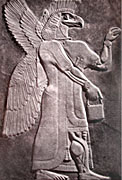

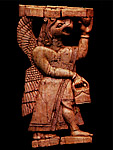

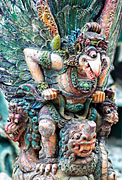 Van's
memory, as the god Enki, has found lodging in the
Siberian area to the
north of his then headquarters in the Kopet Dagh. Here, as in the
Sumerian pantheon, he is the younger son of the Sky god. Also,
Van's responsibilities could easily be summed up as "overseeing the
world and of humans." The author, Thomson Gale, also mentions in
conjunction with the warlord guardian spirits, which includes the
world-overseeing man, the spirit named as the "Winged Old Man" as
appearing in animal form of an eagle. This Shamanistic idea may be at
the root of the eagle headed figures of the Assyrians (first image)
that I have
wondered about on the page Shamanism
and Revealed Religion.
Considering the entanglement of Shamanism and Mesopotamian religious
beliefs I would endorse such a notion. There does not seem to be any
other legitimate answer as powerful as the verified religious beliefs
of the Ob-Ugrian. And who has an ancestral influence on the Assyrians
and
Ob-Ugrians?: the Hurrians. The second winged anthropomorphic figure
(gray) is Hittite. Same figure, different style. What is interesting
about this image is that it could be dated before the
Assyrian images. But as I have mentioned many times, archaeological
based dates are
tricky. The third image is from Urartu, the forth is Hurrian (Mitanni
cylindar seal) and the last image is Garuda a winged eagle headed
figure which is from India and is Hindu. In any case this eagle headed
winged figure is at least well spread
across northern Mesopotamia at an early date and most likely
predates the Sumerians. From what the UB says and what the Sumerian
have written we can conclude these apkallu are related to the Sethite
priesthood. See page The
Apkallu for more info. The UB tells of the last three
Andite migrations between 8000 and 6000 B.C. and within it , "Ten
per cent, including a large group of the Sethite priests, moved
eastward through the Elamite highlands to the Iranian plateau and
Turkestan." (UB 873) So, we know for certain
that
the Sethite
priesthood was in Turkmenistan and with some educated guesswork at
least as far north as the Aral Sea where there was an abundance of
water and food.
Van's
memory, as the god Enki, has found lodging in the
Siberian area to the
north of his then headquarters in the Kopet Dagh. Here, as in the
Sumerian pantheon, he is the younger son of the Sky god. Also,
Van's responsibilities could easily be summed up as "overseeing the
world and of humans." The author, Thomson Gale, also mentions in
conjunction with the warlord guardian spirits, which includes the
world-overseeing man, the spirit named as the "Winged Old Man" as
appearing in animal form of an eagle. This Shamanistic idea may be at
the root of the eagle headed figures of the Assyrians (first image)
that I have
wondered about on the page Shamanism
and Revealed Religion.
Considering the entanglement of Shamanism and Mesopotamian religious
beliefs I would endorse such a notion. There does not seem to be any
other legitimate answer as powerful as the verified religious beliefs
of the Ob-Ugrian. And who has an ancestral influence on the Assyrians
and
Ob-Ugrians?: the Hurrians. The second winged anthropomorphic figure
(gray) is Hittite. Same figure, different style. What is interesting
about this image is that it could be dated before the
Assyrian images. But as I have mentioned many times, archaeological
based dates are
tricky. The third image is from Urartu, the forth is Hurrian (Mitanni
cylindar seal) and the last image is Garuda a winged eagle headed
figure which is from India and is Hindu. In any case this eagle headed
winged figure is at least well spread
across northern Mesopotamia at an early date and most likely
predates the Sumerians. From what the UB says and what the Sumerian
have written we can conclude these apkallu are related to the Sethite
priesthood. See page The
Apkallu for more info. The UB tells of the last three
Andite migrations between 8000 and 6000 B.C. and within it , "Ten
per cent, including a large group of the Sethite priests, moved
eastward through the Elamite highlands to the Iranian plateau and
Turkestan." (UB 873) So, we know for certain
that
the Sethite
priesthood was in Turkmenistan and with some educated guesswork at
least as far north as the Aral Sea where there was an abundance of
water and food.
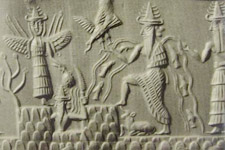
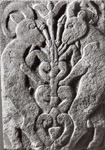
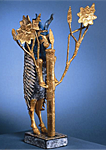 Further
evidence of associations with Enki can be seen to the left. The first
is a Sumerian seal of Enki showing the water coming from him with the
fish as the first and most popular association. The middle is a Hittite
relief with the goat and the Tree of Life. The last is the Sumerian
version labeled as the "Ram in the Thicket" which is a gross misnomer.
It is neither a ram nor a thicket. Both the Hittite and Sumerian art
work have the goat standing on the Tree of Life itself. This is exactly
what the Sumerian epic "Enki and the World Order" says about
the 'Stag of the Abzu' as he is "on board" the stag of the
Abzu with it's "shade
extending over the whole land." But it is confusing as the 'Stag of the Abzu' also refers to a real boat. Part of the shaman's
ritual does include the shaman climbing the Tree of Life. The last
association with
Enki is the eagle which you can see in the first Sumerian seal
impression. Also, the goat is present just under Enki in case you
missed it. "The
three animals
which we see around Enki - the fish, the bird and the horned goat - may
well symbolize the totality of the animal world – all that
flies,
swims or runs. Water is essential to the life of all of them."
(https://scythianwarriorofsatan.wordpress.com/2014/11/01/the-great-stag-by-ida-bobula/)
Further
evidence of associations with Enki can be seen to the left. The first
is a Sumerian seal of Enki showing the water coming from him with the
fish as the first and most popular association. The middle is a Hittite
relief with the goat and the Tree of Life. The last is the Sumerian
version labeled as the "Ram in the Thicket" which is a gross misnomer.
It is neither a ram nor a thicket. Both the Hittite and Sumerian art
work have the goat standing on the Tree of Life itself. This is exactly
what the Sumerian epic "Enki and the World Order" says about
the 'Stag of the Abzu' as he is "on board" the stag of the
Abzu with it's "shade
extending over the whole land." But it is confusing as the 'Stag of the Abzu' also refers to a real boat. Part of the shaman's
ritual does include the shaman climbing the Tree of Life. The last
association with
Enki is the eagle which you can see in the first Sumerian seal
impression. Also, the goat is present just under Enki in case you
missed it. "The
three animals
which we see around Enki - the fish, the bird and the horned goat - may
well symbolize the totality of the animal world – all that
flies,
swims or runs. Water is essential to the life of all of them."
(https://scythianwarriorofsatan.wordpress.com/2014/11/01/the-great-stag-by-ida-bobula/)
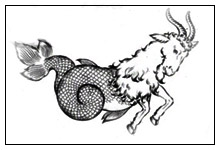
There
are also composite figures associated with Enki. The line drawing is
the fish goat Capricorn, one of the animals of the zodiac which would
be Babylonian, taken from the earlier "animal round" which
is Sumerian. The small sculpture is an apkallu and in this case
represents Oannes the
Babylonian fish man one of the seven sages. Neither of these are Enki himself but are symbolic
representations.
The Goat
"Few animals are more important in mythology than the Goat,
whilst Capella and Capricorn stand in the front rank of stars and constellations."
Robert Brown, Researches into the Origin of Primitive Constellations
of the Greeks, Phoenicians and Babylonians, Williams and Norgate © 1899
As mentioned in a previous paragraph above, Enki is associated with three animal symbols - the fish, the eagle and the goat. Of these three the goat seems the most enigmatic. There is precious little that I have been able to find when searching the most obvious avenues. So I decided to follow my instincts and look into Shamanism. There I found much of what I was looking for.
First, the most important feature of the goat, at least from Central Asia, are the horns:
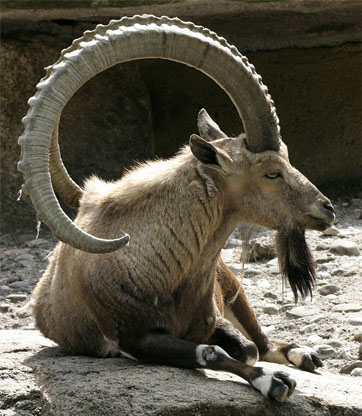 "Ziarat
consist of a stone cairn, decorated with togh, or cloth flags hung from
long poles (Fig. 3). These flags are placed there so that the shrine
can be visible from a distance. Most Afghan ziarat are decorated with
goat horns, which are placed atop the long flagpoles, or on separate
poles of their own, or, alternatively, they are embedded in the earth
around the stone cairn. Unlike the shrine flags, the significance of
these goat horns is more difficult to determine. In present-day
Nuristan (northeastern Afghanistan) goat horns appear as an emblem of
prestige, signifying the number of feasts given by a particular
individual, and so signifying his rank (EDELBERG and JONES 1979, 114).
There is also a separate tradition in Afghanistan which links horns
with warriors. In the Shah Nama (The Epic of Kings), written in the
court of Mahmud of Ghazni during the eleventh century, warriors are
referred to as gow [cow?], bulls, and described as being "possessors of
horns," which meant that they wore horn-decorated helmets. Even today
in Afghanistan there is a common expression, shakh dar at ra beyar,
used when challenging someone, which means "bring out your horned
one," or, in other words, your most powerful person.
"Ziarat
consist of a stone cairn, decorated with togh, or cloth flags hung from
long poles (Fig. 3). These flags are placed there so that the shrine
can be visible from a distance. Most Afghan ziarat are decorated with
goat horns, which are placed atop the long flagpoles, or on separate
poles of their own, or, alternatively, they are embedded in the earth
around the stone cairn. Unlike the shrine flags, the significance of
these goat horns is more difficult to determine. In present-day
Nuristan (northeastern Afghanistan) goat horns appear as an emblem of
prestige, signifying the number of feasts given by a particular
individual, and so signifying his rank (EDELBERG and JONES 1979, 114).
There is also a separate tradition in Afghanistan which links horns
with warriors. In the Shah Nama (The Epic of Kings), written in the
court of Mahmud of Ghazni during the eleventh century, warriors are
referred to as gow [cow?], bulls, and described as being "possessors of
horns," which meant that they wore horn-decorated helmets. Even today
in Afghanistan there is a common expression, shakh dar at ra beyar,
used when challenging someone, which means "bring out your horned
one," or, in other words, your most powerful person.
The
ancient religious significance of the goat in Afghanistan is clear, as
we have already noted, from the various ritual goat-burials unearthed
by archaeologists (DUPREE et al. 1972, 12-13, 81-82; DUPREE 1973, 215).
Indeed, these finds have been interpreted as signifying the presence of
a Central Asiatic goat-cult dating back to either the Neolithic (DUPREE
1973, 264-266) or the Bronze Age (SHAFFER 1978, 81-83). The discovery
at Teshik-Tash of a Neanderthal burial site on the banks of the Oxus
River,[5] in which several pairs of goat horns had been arranged around
the body, suggests that goat horns had ritual significance at an even
earlier date (GOWLETT 1984, 107). The present-day association of goat
horns with ziarat may well reflect the tenacity of pre-Islamic
elements." (http://www.khyber.org/publications/041-045/afghanshaman.shtml)
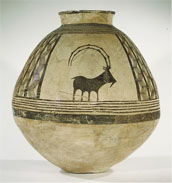 These goat horns of Central Asia are impressive and serious looking and are a far cry from what you see in some artistic
renderings. The horns in Mesopotamia are an important symbol of
divinity and virility and
are reminiscent of the Mesopotamian "horned cap" of the gods. It is the
ibex pictured above that has the strongest goat association to Enki (also
shown on the decorated pottery).
These goat horns of Central Asia are impressive and serious looking and are a far cry from what you see in some artistic
renderings. The horns in Mesopotamia are an important symbol of
divinity and virility and
are reminiscent of the Mesopotamian "horned cap" of the gods. It is the
ibex pictured above that has the strongest goat association to Enki (also
shown on the decorated pottery).
The second reason is the goat's relationship to fertility:
"Gods
could be worshipped via a representative animal, which made animal
cults and totemistic practices part of Paleolithic man's psychological
landscape. Many archeological excavations suggest that primative man
performed a host of animal rituals, ranging from the glorification of
animal deities, to animal sacrifice, or simply showing great respect
for specific animals.
For example, horned animals, particularly the ibex,
were worshipped as icons in the prehistoric Near East; they are
protrayed on pottery dating as far back as 5500 BC. One explanation
given for this worship is that it derives from the goat's remarkable
sex drive. Generally speaking, goats have always been viewed as symbols
of fertility....In early Babylonian times the god Ea, protector of its
people and the bringer of knowledge and civilization to humanity, was
portrayed as a goat."
(Manfred F.R. Kets de Vries, Talking to the Shaman Within: Musings on Hunting, © 2014 Manfred F.R. Kets de Vries)
One of Enki's attributes is fertility and according to various texts he, as a lusty god, did have a well known strong sex drive.
The third reason comes from Shamanistic rock art. The following is from Ughtasar in eastern Armenia:
 "Motifs
- goats rule! Of the 977 rocks recorded images of goats
consistently predominate among the figurative motifs, appearing on a
total of 515 rocks and representing 65.3% of all identifiable
figurative motifs. Humans, some with enormous hands, are the next
highest in number, appearing on 166 rocks (16.3% of figurative motifs).
Felines feature on 74 rocks (6.7%), while zigzags or snakes
appear on 42 rocks, making up 3.5% of the figurative motifs.
Other animals including stags, bulls and canines are less
frequently depicted. There are also many enigmatic abstract motifs,
perhaps holding meaning for only a minority of participants,
practitioners and viewers of the rock art.
"Motifs
- goats rule! Of the 977 rocks recorded images of goats
consistently predominate among the figurative motifs, appearing on a
total of 515 rocks and representing 65.3% of all identifiable
figurative motifs. Humans, some with enormous hands, are the next
highest in number, appearing on 166 rocks (16.3% of figurative motifs).
Felines feature on 74 rocks (6.7%), while zigzags or snakes
appear on 42 rocks, making up 3.5% of the figurative motifs.
Other animals including stags, bulls and canines are less
frequently depicted. There are also many enigmatic abstract motifs,
perhaps holding meaning for only a minority of participants,
practitioners and viewers of the rock art.
"It has long been
recognized that goats play a dominant role in Armenian rock art but the
quantitative survey at Ughtasar has enabled the research team to
demonstrate that goats, assumed from their massively exaggerated horns
to be both wild and male account for almost two-thirds of all
figurative motifs.
"The collected data,
together with other characteristics of the ‘art’, make it
possible to use models such as that of Layton (2000) and others (Sauvet
et al, 2009) to assign the character of the rock art to such categories
as ‘totemic’, ‘shamanic’ or
‘secular’. In this context Ughtasar appears to match
Layton’s criteria for a ‘shamanic’ site: goats appear
at least twice as frequently as the mean for the remaining figurative
motifs. The distribution map also indicates that they are distributed
with similar frequency across the area surveyed so far.
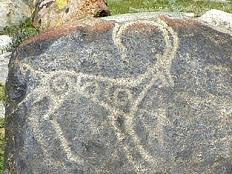 Perhaps
goats acted as ‘spirit guardians’ or vehicles for spiritual
activity of various kinds. Analogous accounts of animals thought to
have acted as ‘spirit helpers’, such as the eland in
southern African rock paintings or the bighorn sheep on petroglyphs in
the Cosos Mountain Range of California have also been interpreted as
‘shamanistic’ in character (Lewis-Williams & Dowson
2000; Whitley, 2011). Research is ongoing into the intriguing question
of why goats were so important for those who created the rock art of
Armenia and western and Central Asia."
(http://ughtasarrockartproject.org/results.html)
Perhaps
goats acted as ‘spirit guardians’ or vehicles for spiritual
activity of various kinds. Analogous accounts of animals thought to
have acted as ‘spirit helpers’, such as the eland in
southern African rock paintings or the bighorn sheep on petroglyphs in
the Cosos Mountain Range of California have also been interpreted as
‘shamanistic’ in character (Lewis-Williams & Dowson
2000; Whitley, 2011). Research is ongoing into the intriguing question
of why goats were so important for those who created the rock art of
Armenia and western and Central Asia."
(http://ughtasarrockartproject.org/results.html)
The above reasons of why Enki is associated with the goat should give you an indication of the underlying power of the shamanistic influence from Central Asia. It also shows just how complicated and perhaps obscure the answers to Mesopotamian symbolism really are.
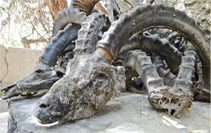
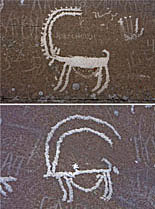 A spiritual belief involving the goat in Central Asia continues down to
the present day. The photo is from a spirit shrine in Langar Tajikistan
and shows a collection of goat heads including a collection of just the
horns. This tells you how important the horns are and how tenacious the
olden beliefs remain a strong influence. The petroglyphs, at least
several thousand years old, are from the same area.
A spiritual belief involving the goat in Central Asia continues down to
the present day. The photo is from a spirit shrine in Langar Tajikistan
and shows a collection of goat heads including a collection of just the
horns. This tells you how important the horns are and how tenacious the
olden beliefs remain a strong influence. The petroglyphs, at least
several thousand years old, are from the same area.
(http://insearchoflostplaces.com/2016/11/langar-tajikistan/)
You just never know. Somethings seem to arrive out of the blue. This is the first research I have done with any depth for Central Asia concerning the proto-Hurrians those earliest Hurrians/Sabirs. The sentence linking Sabir with Siberia may be another link between Mesopotamia and the Shaman along with those enigmatic eagle headed reliefs from Mesopotamia. But as usual there are other theories for the origin of the name Siberia. For me, which is probably showing my bias, this one makes a lot of sense. Partly based on the fact that they carry those same Andite legends and partly on the fact that the name Sabir, or some version of it, was so well known. Another surprise was the "Winged Old Man." That really was out of the blue. I knew about the Hungarian connection from earlier research but this latest effort has cleared up many of the gray areas, particularly linguistic, and gave me a more overall picture that I could understand. There is, as usual, one last thing. That is climate and how world events are effected by it. To revisit the Andites who were already in Central Asia in large numbers, an increasing aridity around 8000 BC was starting to drive the Andites from Turkmenistan into neighboring areas which includes the lands about the Euphrates (UB 878). That timing is just before various civilizations and peoples begin to appear on the map. So Central Asian influences were already afoot in and about Mesopotamia when those religious monuments were first being carved. For me it is no stretch to see the eagle headed Winged Old Man represented in Assyrian, Urartian and Hittite art. It also is no surprise to see them connected with the Sethite priests although I do not understand the forces involved in its fusion. There may be a Babylonian connection. "But ever-increasing drought gradually brought about the great Andite exodus from the lands south and east of the Caspian Sea. The tide of migration began to veer from the northward to southward, and the Babylonian cavalrymen began to push into Mesopotamia." (UB 879) This contributed further to the end of Sumeria. But perhaps the start of the apkallu and their association with kingship. "After the breakup of the early Sumerian confederation the later city-states were ruled by the apostate descendants of the Sethite priests. Only when these priests made conquests of the neighboring cities did they call themselves kings." (UB 876)
This
page is a good example of the mixing of Shamanism and Mesopotamian
beliefs. Starting with the proto-Hurrian who would have had both
shamans and that legendary pre-Mesopotamian background we get to Enki
the
eagle headed winged god with his association with goats and the World
Tree. There is a mixing of the world caretaker role with the World
Watching Man, the aspu with the river and astrology linking
his winged horse to Pegasus. Then back again, mixing the ancient Shaman
imagery with the persona of Enki creating compound mythical
characters such as the fish apkallu, the goat fish and the familiar winged eagle headed genii
of the Tree of Life. Shamanism had a profound impact on Mesopotamian
beliefs in that Shamanism as the evolutionary religion of early man was
grafted with the history of the rebellion and all which that entails to
produce a hybrid belief system that we call the Sumerian pantheon.
You never know, I
was not even going to write this page.
Thank you for reading.
 Back to Intro
Back to Intro Van
Van![]() Shamanism and Revealed
Religion
Shamanism and Revealed
Religion The Apkallu
The Apkallu First Legend Introduction
First Legend Introduction
